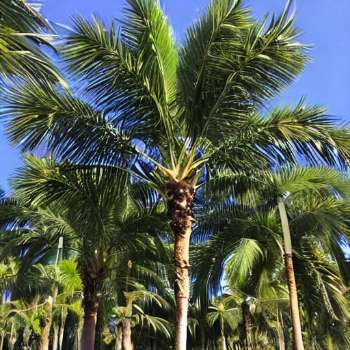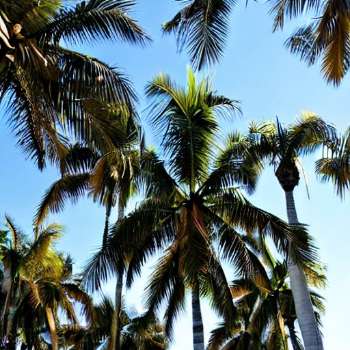Palm trees do not have growth rings like other trees. When leaves stick to a palm tree’s trunk, they leave scars that look like rings which used to calculate age of palm trees. The marks means that how old the tree is and how it grew.
You can figure out the age of a palm tree is by counting the rings on its trunk, looking into its history, noticing how thick its trunk is, thinking about how tall it is overall, or making a guess based on the type of palm.
The vascular cambium tissue necessary for the secondary development that results in the production of growth rings in dicot trees is absent from palm plants. Because of this, palm trees do not develop regular growth rings or increase in diameter with age. Instead, the rings that may be seen on a palm tree’s trunk are really scars from where leaves or fronds were attached.
When a tree loses its old leaves, it leaves behind these scars. Older leaves fall off the tree each year while fresh ones emerge at the tree’s top. These leaves’ attachment sites to the stem have left behind circular, ring-like markings. Similar to how growth rings in other trees correlate to the tree’s yearly growth, these rings do not. As an alternative, they illustrate the development of leaf attachment and shedding.
The number of these rings does not precisely correspond with the tree’s chronological age, therefore counting them in an attempt to estimate the age of a palm tree is not a reliable technique. Furthermore, palm trees are unable to create cambium, the tissue that gives dicot trees their growth rings.
Palm trees are not only beautiful and iconic, but they also hold fascinating secrets within their trunks. One such mystery lies in the rings that adorn their trunks. These rings serve as silent witnesses to the palm tree’s journey through time, telling a story of growth, resilience, and the environment it has thrived in.
By closely examining these rings, we can unlock valuable information about the tree’s age, health, and past. We will explore the meaning behind the rings on a palm tree and delve into the insights they provide about the tree’s life. So, let’s peel back the layers and unravel the secrets hidden within these remarkable natural markers.
1. Understanding Palm Tree Anatomy
The structure of a palm tree comprises various components that play significant roles. One such feature is the rings found on the trunk. These rings, which vary in width, reveal important information about the tree’s lifespan. Each ring represents a year of growth, similar to the rings on a tree stump.
By examining the rings, arborists and botanists can determine the age of the palm tree and its growth rate. Additionally, the rings can provide crucial insights into the health and conditions the tree experienced over the years. Thick rings usually indicate favorable conditions, while thin rings may suggest periods of drought or stress.
Understanding palm tree anatomy and the significance of these rings enables us to appreciate the intricate lifespan of these remarkable trees.

2. Interpreting The Rings On A Palm Tree
The rings on a palm tree hold a hidden story, serving as a divine record of its growth. Each ring symbolizes a year of the palm tree’s life, unveiling its journey and experiences. These rings, when carefully examined, showcase patterns that help identify the palm’s growth.
From studying the width and spacing of the rings, experts can determine the palm’s age and its response to different climatic conditions. But beyond their scientific significance, these rings also hold cultural and symbolic meanings. In various cultures, the palm rings are associated with wisdom, strength, resilience, and the tree’s ability to thrive in harsh environments.
People have interpreted these rings as a representation of the tree’s ability to adapt, learn, and overcome challenges. Exploring the rings on a palm tree not only reveals its physical growth but also unveils a deeper story of endurance and resilience.
Also Read : 22 Interesting Facts About Palm Trees
3. Factors Influencing Palm Tree Ring Formation
The formation of rings on a palm tree is influenced by various factors, including climate and weather conditions. The type of soil composition and the availability of essential nutrients also play a significant role. Additionally, seasonal changes, particularly periods of drought, can impact the development of these rings.
Palm trees adapt to their surroundings and create rings as a response to external influences. Climate variations, such as temperature and humidity, affect the growth rate of the tree, which subsequently leads to the formation of distinct rings. Similarly, the soil composition and nutrient availability determine the tree’s overall health and growth pattern.
During times of limited water supply, as experienced during droughts, the palm tree conserves resources, resulting in the formation of narrower rings. Overall, the rings on a palm tree serve as a record of its growth and the environmental conditions it has encountered.
4. Counting The Years: Calculating The Age Of A Palm Tree
Palm trees, with their iconic rings, are mesmerizing to behold. Determining their age is no easy task. Various methods have been developed to calculate a palm tree’s age. However, accurate estimation can pose challenges. One such challenge is the discrepancies in growth rates among palm trees.
Some factors, like environmental conditions and species, can influence growth rates. These disparities make it difficult to rely solely on size or number of rings to determine a palm tree’s age. Additionally, different methods, such as counting leaf scars or tree rings, may yield different results.
Nonetheless, experts continue to refine these methods and enhance our understanding of palm tree longevity. Unraveling the mysteries of these magnificent trees remains an ongoing endeavor.
Also Read : How to Bring a Dying Palm Tree Back to Life: Essential Steps

5. Ancient Palms: Examining Historical Insights
Fossilized palm tree rings provide valuable insights into the ancient growth patterns of these iconic trees. By studying these rings, scientists can uncover a wealth of information about climate conditions, environmental changes, and even the lifespan of individual palm trees.
These rings serve as a testament to the rich history of these majestic plants, offering glimpses into the past and the stories they hold. With each ring representing a year of growth, they serve as natural archives of the palm tree’s journey.
By analyzing the width, density, and composition of these rings, researchers can paint a vivid picture of the palm tree’s life and the world it thrived in. Through this fascinating exploration, we can better understand the palm tree’s role as a witness to the past and its remarkable adaptability over time.
6. Taking Care Of Palm Trees
Palm trees require proper care to ensure optimal growth conditions. Regular pruning and trimming techniques are essential. This helps maintain the tree’s shape and remove any dead or diseased fronds. Moreover, it promotes air circulation and prevents the risk of falling branches.
Preserving the health and longevity of palm trees involves providing adequate water and nutrients. Avoid over-watering or underwatering, as both can negatively impact the tree’s health. Additionally, using a slow-release fertilizer specifically formulated for palm trees is crucial. It provides essential nutrients without causing excessive growth.
Regularly inspect the trees for signs of pests or diseases and take appropriate measures to prevent or treat them. By following these guidelines, palm trees can thrive and enhance the beauty of any landscape.
7. Palm Tree Rings: Fascinating And Aesthetic
Palm tree rings possess a captivating allure that transcends their natural significance. These concentric circles, formed by the tree’s growth patterns, hold an innate aesthetic charm that has inspired various art forms and designs. The utilization of palm tree rings in creative endeavors is a testament to the influential power of nature.
Artists and designers draw inspiration from these intricate patterns to craft visually stimulating and thought-provoking works. The rings’ unique texture and symmetrical arrangement lend themselves to captivating visual compositions. Whether it be through exquisite paintings, jewelry pieces, or even home decor, the incorporation of palm tree rings adds a touch of organic elegance to any artistic creation.
Their serene beauty serves as a reminder of the beauty and intricacy found in the natural world and offers endless creative possibilities for those who seek inspiration from it.
Frequently Asked Questions For What Do The Rings On A Palm Tree Mean
What Do The Rings On A Palm Tree Mean?
The rings on a palm tree indicate the age of the tree. Each ring represents one year of growth. By counting the rings, you can estimate the tree’s age and get a sense of its history. Other factors like climate and growing conditions can also impact the formation of rings.
Conclusion
Palm trees have long been a symbol of beauty, strength, and resilience. Their rings, often referred to as growth rings or whorls, tell a story of their journey and the unique conditions they have experienced. Each ring represents a year of growth and reveals valuable information about the health and age of the tree.
By examining the rings, experts can determine the past climate conditions, potential diseases, and the overall vitality of the palm. Moreover, these rings are not just a fascinating scientific phenomenon, but also a reminder of the importance of adaptability and perseverance in our own lives.
Just like the rings on a palm tree, our experiences shape us and make us stronger. So, the next time you come across a palm tree, take a moment to appreciate its rings and the countless stories they hold. They serve as a reminder that growth is a continuous process, and there is beauty in every phase of life.
